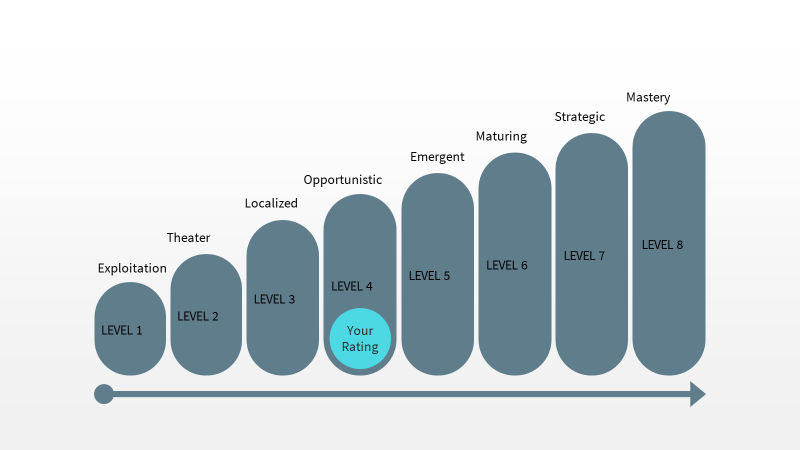
What is it like to work in an organization that has attained high levels of innovation mastery? It’s growth-oriented, future-focused and unrelentingly positive. And by taking small steps, the place you work can be more like that, too.
What is it that allows some organizations to grow consistently, year-in and year-out, while others falter? In my own research on an unusual group of companies I called “growth outliers,” I found a management pattern. It is, as Safi Bahcall likes to say, the orchestration of “life at 32F.”
Innovation confusion
It’s a dirty little secret – for all the talk of “innovate or die,” all the boot camps, all the money spent on training and all the books, articles and punditry – most companies still don’t have a well-oiled system for managing their innovation process.
What’s needed is a management system that allows you to master innovation at the level of the organization. Not one person’s championed idea. Not an on again off again, “oh dear, we had a bad quarter” proposition. Not “well, that was fun, back to business as usual” once the boot camp is over.
What you see in organizations with higher levels of innovation mastery are a set of practices that are baked into its operations, supported by complementary measurement and guidance systems and managed through consistent structures. We’re talking firms such as Netflix, Amazon, Facebook, and Alibaba, of course, but also companies not ‘born digital’ who have nonetheless figured out how to make innovation more than just theater.
So, what does it look like?
Forget ‘best practices’ – every firm tackles the innovation challenge in its own way. What you can measure is the presence, or absence, of factors that suggest higher or lower levels of mastery. This prompted us at Valize to develop a simple, but powerful survey instrument which you can use to trace indicators of innovation mastery at your own organization.
A word about Valize – some years back, I got really frustrated by the reality that a lot of good ideas (among them discovery driven planning, the reverse income statement, customer consumption chains, growth-oriented leadership practices and so on) went missing in translation. I founded Valize with the idea that it would be a company that could create tools and practical applications to take these ideas and bring them to life for real.
8 levels of mastery
The innovation mastery scale looks at 8 potential levels of mastery. At low levels, there is basically no innovation function.
This graphic gives you an idea of the progress a company can make through the stages:
At high levels of innovation mastery, you have a governance and funding system that is oriented toward the future, metrics and accountability that incentivize the future, a set of cultural expectations that future-friendly behavior is not only accepted but demanded, and people and structures that support innovation.
Moving from stage to stage
Let’s say you’ve concluded that you have a low level of mastery. You probably want to begin with some training to get people familiar with the tools of innovation. A senior level workshop or two to create awareness is useful. Then, I suggest you start with one or two small projects to help people apply the tools and concepts. As you build proficiency, you’ll want to spread success stories widely, learn to apply appropriate decision processes and create groups of people who are gaining skill at innovation. When you get to high levels of proficiency, you should have a pipeline of innovations; a solid governance and funding process; employees trained & knowledgeable about the process and customers delighted with how well you are serving them!
Curious about how your organization would stack up?
At Valize, we create a survey specifically for your organization. You tell us who should complete it on your end – we recommend a good mix of people from various hierarchical levels, geographies, lines of business – you decide. Each person will get an invitation to respond. We gather up the responses, analyze the data and get you a report which offers our observations on what the data suggest.
The goal here is not to give your organization some kind of grade. Rather, it’s to create an understanding of where you are in the innovation journey.
Actionable ideas
Whether you do the survey or not, you can start to experiment, in a low-cost way, to build higher levels of innovation capability.
For instance, if the responses to the question “How difficult would it be for you to get small amounts of experimental capital to test a new idea?” were “nearly difficult, almost impossible,” you could run a pilot along the lines of the Adobe Kickbox system.
If people report that they simply don’t have the time to innovate, that’s where a management intervention to free up bandwidth might begin to make a difference.
Try a little, learn something, try a little more, and you can find yourself moving up the scale into a far more adept balance between the pull of the here-and-now and the necessity of building for the future.
Lessons from the Growth Outliers
What I found in my ‘growth outliers’ research was a fascinating mix of stability and dynamism that went into the instruments in the survey.
Dynamism
Small early bets.
A portfolio management approach.
Active acquirers, but mostly of bolt-ons and fill-ins.
Central management of resources.
Speed and flexibility with some sacrifice of efficiency.
Innovation is part of everyday operations.
Stability
What was equally important was that innovation took place against a backdrop of carefully designed stability. The changes, while cumulating to big outcomes, were incremental and evolutionary.
Culture and shared values.
No drama.
Talent magnets.
Relatively slow changes of strategy.
A reliable and well connected customer base.
Stable leadership.
Arranging to take the assessment
If you’d like to give it a spin, contact growth@valize to set up a demo. Its easy to get started, so give us a call and we’ll help you kick off your Innovation Mastery journey.
You can watch a video explainer here:

